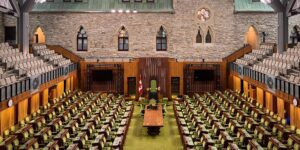Deputy Prime Minister and Minister of Finance, Chrystia Freeland, tabled the federal government’s 2023 Budget, entitled “A Made-in Canada Plan: Strong Middle Class, Affordable Economy, Healthy Future”, in the House of Commons.
In the Budget, the Government recognizes the Bank of Canada has aggressively raised interest rates to combat increased inflation, largely due to persistent global supply chain issues because of the COVID-19 pandemic and the war in Ukraine, which has resulted in slower growth for the Canadian economy.
This slow-down has resulted in a roughly $5.7 billion projected loss in government revenue this year. However, the Government also points out inflation has been going down over the last 8 months with the Bank of Canada projecting the inflation rate to be roughly 2.6% by the end of the year.
By comparison, there are 830,000 more Canadians at work now than pre-pandemic levels, which is a higher percentage than the United States, and the debt-to-GDP ratio is much lower than the rest of the G-7 (although they are expecting a small up-tick this year before reducing in future years).
The projected deficit last year is expected to be $43 billion, up nearly $10 billion from what was projected in the Fall Fiscal Statement in November of last year. Gradually, the deficit is forecast to decline to $14 billion by 2027/28.
Overall, the federal government is trying to strike a balance in the Budget between helping lower-income Canadians weather these inflationary pressures, and making longer term competitive investments in the green economy in response to the US’ Inflation Reduction Act, all while attempting to maintain a strong fiscal position.
Budget 2023 projects an overall spending increase of $70 billion over the next 5 years that will be partially offset through other cost reductions of $25 billion. This jump in spending includes the new $198 billion healthcare agreement with the provinces and territories announced last month.
Some other highlights of today’s Budget include:
Affordability
- A “Grocery Rebate”, which is essentially a GST credit, will help 11 million households deal with inflationary pressures, estimated to be worth $2.5 billion. The average eligible couple with two children can expect to receive $467.
- $13 billion over five years to expand dental care for 9 million uninsured Canadians with incomes less than $90,000 per year.
- Increasing the limit on Registered Education Savings Plan (RESP) withdrawals from $5,000 to $8,000 per year.
- A system of Tax-Free First Home Savings Accounts to be in effect by April 1, 2023.
- Attempting to “crackdown” on hidden consumer fees (i.e. on concert tickets, airline baggage, telecom roaming, etc) and predatory loans.
- Capping the excise tax increase on alcohol at 2% for one year.
Green Economic Investments
- A 15% refundable tax credit for eligible investments to support and accelerate clean electricity, including:
- Non-emitting electricity generation systems: wind, concentrated solar, solar photovoltaic, hydro (including large-scale), wave, tidal, nuclear (including large-scale and small modular reactors);
- Abated natural gas-fired electricity generation (which would be subject to an emissions intensity threshold compatible with a net-zero grid by 2035);
- Stationary electricity storage systems that do not use fossil fuels in operation, such as batteries, pumped hydroelectric storage, and compressed air storage; and,
- Equipment for the transmission of electricity between provinces and territories.
- A refundable tax credit equal to 30 per cent of the cost of investments in new machinery and equipment used to manufacture or process key clean technologies, and extract, process, or recycle key critical minerals, including for:
- Critical minerals essential for clean technology supply chains, specifically: lithium, cobalt, nickel, graphite, copper, and rare earth elements;
- Manufacturing of renewable or nuclear energy equipment;
- Processing or recycling of nuclear fuels and heavy water;
- Manufacturing of grid-scale electrical energy storage equipment;
- Manufacturing of zero-emission vehicles; and,
- Manufacturing or processing of certain upstream components and materials for the above activities, such as cathode materials and batteries used in electric vehicles.
- The Canada Infrastructure Bank (CIB) will invest at least $10 billion through its Clean Power priority area, and at least $10 billion through its Green Infrastructure priority area. This will allow the CIB to invest at least $20 billion to support the building of major clean electricity and clean growth infrastructure projects.
- The Canada Growth Fund will support clean growth projects through “contracts for difference”. These contracts would backstop, for example, the future price of carbon or hydrogen, providing predictability that helps to de-risk major projects that cut Canada’s emissions. Contracts for difference allow companies to plan ahead, supporting growth of Canada’s clean economy by making clean projects more cost-effective.
- The government will work with the biofuels industry to look at specific supports to expand opportunities.
- An enhanced Investment Tax Credit for Carbon Capture, Utilization, and Storage:
- Including dual use heat and/or power equipment and water use equipment, with tax support prorated in proportion to the use of energy or material in the carbon capture, utilization, and storage process, subject to certain conditions;
- In addition to projects in Saskatchewan and Alberta, the tax credit would be available to projects that would store CO2 using dedicated geological storage in British Columbia;
- Requiring projects storing CO2 in concrete to have their concrete storage process validated by a third-party based on an ISO standard prior to claiming the investment tax credit; and,
- Including a recovery calculation for the investment tax credit in respect of refurbishment property.
These are some of the major highlights of the 2023 Budget. The budget documents contain a large number of clarifications related to initiatives announced in the Fall Fiscal Statement last November, as well as changes to some programs and initiatives that already exist.
Related Links:
Budget 2023: A Made-in-Canada Plan: Strong Middle Class, Affordable Economy, Healthy Future
We’re Here to Help
For further information about what new opportunities the federal budget may create for Canada’s business community, please contact:
Tara Bingham – Vice-President
tara@prairieskystrategy.ca
204.390.7760
Brian Gilbertson – Senior Strategy Advisor, Ottawa
brian@prairieskystrategy.ca
587.393.7755
To learn more about Prairie Sky Strategy, please visit our website.





